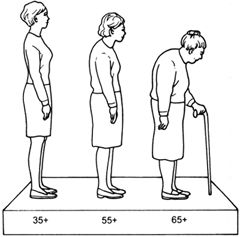Osteoporosis has reportedly emerged as a silent yet daunting and debilitating major health epidemic, according to US government statistics, demonstrating that around 10 million Americans are suffering from the physical challenges brought about by the bone disease. About 34 million people have been reported to have decreased bone density, subsequently placing them at an increased risk for the condition’s symptomless development. The staggering proportions of osteoporosis have reportedly prevailed in taking an uphill slope, showing a 300 percent increase over the last three decades in the United States alone.
Among the many different bone diseases classified in medical terms, osteoporosis have been reported to be the most common, soaring among the ranks of various bone conditions such as Paget’s disease and other bone deficiencies, affecting over 200 million people all over the world. Although its prevalence may differ by age, gender, and geographical location, substantial indications demonstrated by worldwide statistics reports show how osteoporosis has surfaced as a disease that has plagued millions of individuals with a string of physical challenges and impairment.
As cited by medical journals, osteoporosis is a bone disease characterized by the thinning of bone tissue and loss of bone density over  time. The medical condition has been known to cause a person’s bones to become excessively frail and brittle, weak enough to put the afflicted to an increased susceptibility to fractures even from mild stresses like bending over or coughing. While osteoporosis has been reported to strike its prey irrespective of age, gender and race, it has been found more frequently in people over 50 years old, has been observed as more prevalent in women, and recognized as common in individuals of Caucasian or Asian descent.
time. The medical condition has been known to cause a person’s bones to become excessively frail and brittle, weak enough to put the afflicted to an increased susceptibility to fractures even from mild stresses like bending over or coughing. While osteoporosis has been reported to strike its prey irrespective of age, gender and race, it has been found more frequently in people over 50 years old, has been observed as more prevalent in women, and recognized as common in individuals of Caucasian or Asian descent.
The development of osteoporosis may not be solely attributable to biological factors such as sex, age, race, frame size, and medical or family history of fractures, medical experts say, pointing out that as were other diseases, a person may also acquire the bone deficiency as a result from lifestyle choices, or a complication from another medical condition and its corresponding treatment. These risk factors include insufficient levels of certain minerals and vitamins in the body such as calcium and vitamin D, unhealthy habits such as sedentary lifestyle, smoking, and excessive alcohol intake, which also have been attributed to the long-term use of certain medications used to combat or prevent seizures, cancer, transplant rejection, gastric reflux, and depression.
While osteoporosis has been dubbed as a “silent” killer due to its symptomless development, a person may take the disease’s first warning signs from fall or fracture-related pain at certain areas of the body. An individual who may be afflicted with osteoporosis may recognize its symptoms from frequent back pains or loss of height, broken hips from doing even routine activities, wrist pain from a minor fall or bump, and rib fracture from coughing, sneezing, bending over, or twisting.
Treating osteoporosis is based on prevention, according to medical experts, explaining that the approach normally taken to respond to the disease is based on preventing fractures through the use of medication that may help strengthen a person’s bones. However, certain drugs indicated for osteoporosis such as Fosamax, otherwise known by its generic equivalent alendronate, has been reportedly associated with a number of inadvertent effects, including a rare jaw disorder known in medical terms as osteonecrosis.
Despite the challenges of identifying and responding to the condition, its recognition and treatment is far from impossible, orthopedic specialists say, explaining that for as long as a person puts the illness at the forefront of his or her mind as one ages, and be especially keen to its risks factors and stealthy yet prevailing manifestations, he or she or even a loved one may be spared from its detrimental and disabling effects. Everybody — men or women, young or old, Caucasian or not — are encouraged to consult a doctor or a bone specialist as soon as any unusual aches from an ordinary routine becomes extremely painful, bothersome, and threatening to possibly prevent and lessen the impact of osteoporosis.
URL References:
livestrong.com/article/215272-aches-from-osteoporosis/
aaos.org/about/papers/position/1113.asp
mayoclinic.com/health/osteoporosis/DS00128/
peak-personaltraining.com/article-osteoporosiscalcium.html
ncbi.nlm.nih.gov/pubmedhealth/PMH0001400/
 give remedy to it, according to an international wire agency service. Fosamax is a prescription drug used to treat osteoporosis or osteopenia, especially in women. However, early detection of bone problem may lead to over treatment with Fosamax. Medical associations have raised fears that when Fosamax is overly used, this may raise the risk of some women to unusual incidences of femur fractures.
give remedy to it, according to an international wire agency service. Fosamax is a prescription drug used to treat osteoporosis or osteopenia, especially in women. However, early detection of bone problem may lead to over treatment with Fosamax. Medical associations have raised fears that when Fosamax is overly used, this may raise the risk of some women to unusual incidences of femur fractures.






